Jet Provost T.Mk.5 & Strikemaster Mk.80A/88
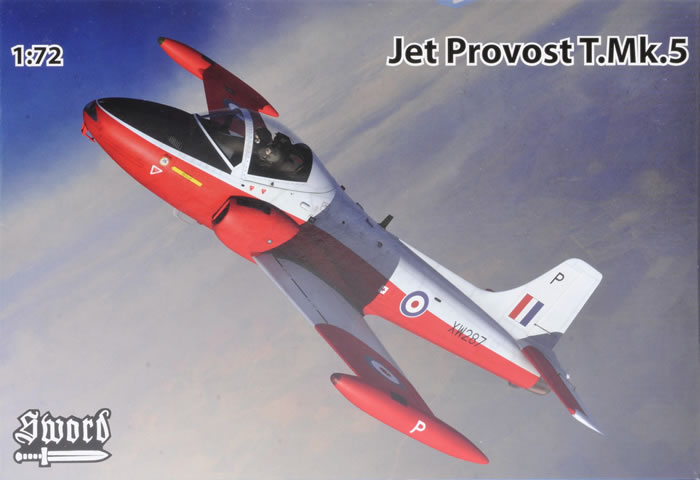
Sword, 1/72 scale
S u m m a r y |
Catalogue Number: |
SW72089 – Jet Provost T.Mk.5
SW72090 – Strikemaster Mk.80A/88 |
Scale: |
1/72 |
Contents & Media: |
Each kit has seventy-six grey and ten clear styrene parts, two resin parts, and decals for two subjects (but with four colour scheme choices in the Strikemaster’s case). |
Price: |
Available on-line from these stockists: |
Stockist |
Jet Provost |
Strikemaster |
Sword |
€14.44 |
€14.44 |
Hannants |
£10.82 |
£10.82 |
Squadron |
US$28.80 |
US$28.80 |
Modelimex |
€14.46 |
€14.46 |
West Coast Hobbys |
Can$23.00 |
Can$23.00 |
Hobby Link Japan |
¥2,430 |
¥2,430 |
Click here for currency conversion. |
Review Type: |
First Look. |
Advantages: |
Good surface detail, accurate appearance, good value too, from the right supplier. |
Disadvantages: |
No harness detail on the resin ejection seats, numerous detail differences between instructional drawings and kit parts. |
Conclusions: |
Both kits are a big improvement on the sound but now dated Airfix kit.
I like Sword kits, and this one has many of the brand’s good attributes, not least very nice surface detail. However, after several years of reviewing them, I still feel Sword rushes things to get to market (perhaps because an almost pathological concern amongst many Czech kit makers that someone else will release the same subject first).
There are numerous differences between the constructional drawings and kit parts that hint even more detailed and better kits were intended compared to what has been realised. This ‘sloppiness’ in the instructions fortunately has no real impact on assembly.
The biggest disappointment has to be the ejection seats and their lack of harness detail. Given the huge canopy, this is a poor effort when compared to similar Sword kits. In fact, this subject’s cockpit really warrants the coloured PE treatment like Sword gave their two-seat Lightnings. I am sure buyers would accept a slight price premium for this extra. Fortunately, Pavla’s Strikemaster and Obscureco’s Jet Provost T.Mk.5 resin cockpit sets for Airfix’s kit should suit the Sword kits too.
I happily recommend both kits as being the best examples to date in “The One True Scale”, but lament that their cockpit detail is not on par with Sword’s best. |
Reviewed by
Mark Davies

Sword's 1/72 scale Jet Provost / Strikemaster is available online from
Squadron.com
The BAC Jet Provost (originally built by Hunting Percival) was a British jet-powered trainer aircraft used by the Royal Air Force (RAF) from 1955 to 1993. The Jet Provost was also successfully exported, serving in many air forces worldwide. A more heavily armed variant of the airframe was developed as the BAC Strikemaster.
In the 1950s the RAF issued a requirement for a new dedicated jet training aircraft. Hunting Percival developed the Jet Provost from the piston-engined Percival Provost basic trainer. On 16 June 1954, the prototype XD674 made its first flight from the factory at Luton Airport, flown by Dick Wheldon. The Air Ministry ordered ten of the Jet Provost T1.
In June 1957, an order was placed for the first 40 of the developed Jet Provost T3, featuring a more powerful Armstrong Siddeley Viper jet engine, ejector seats, a redesign of the airframe, and a shortened and strengthened version of the retractable tricycle undercarriage. In total, 201 T3’s were delivered between 1958 and 1962.
The T4 followed in 1960, fitted with a more powerful variant of the Viper engine and first flown on 15 July, and this was followed by the pressurised T5 in 1967.
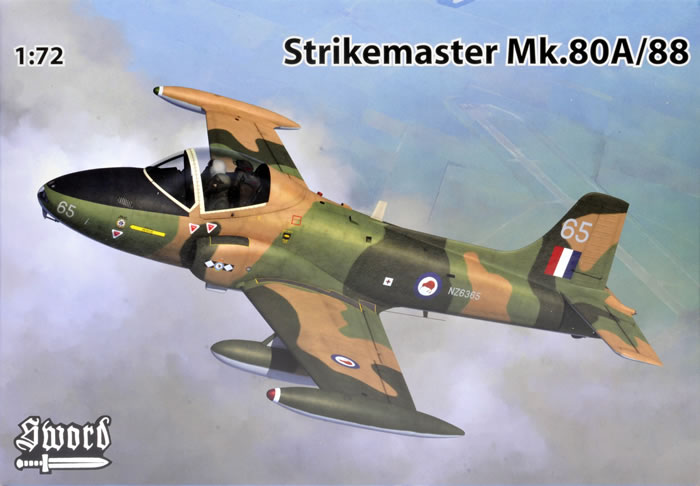
The T51 was an armed export version, sold to Ceylon (Sri Lanka), Kuwait and Sudan. It was armed with two 7.7-mm (0.303-inch) machine guns. The T52 was another export version sold to Iraq, South Yemen, Sudan and Venezuela, with the same armament as the T51. The T55 was the final armed export version which was sold to Sudan.
The BAC 167 Strikemaster is essentially an armed version of the Jet Provost T Mk 5; the Strikemaster was modified with an up-rated engine, wing hard points, a strengthened airframe, new communication and navigation gear, up-rated ejection seats, shortened landing gear, and a revised fuel system including conformal fuel tanks on the wing tips. First flown in 1967, the aircraft was marketed as a light attack or counter-insurgency aircraft, but most large-scale purchasers were air forces wanting an advanced trainer, although Ecuador, Oman and Yemen have used their aircraft in combat. One hundred & forty-six were built.
Source: Wikipedia
(Mention of the Strikemaster makes me recall 1985 when I was an NZ Army officer living in married quarters on RNZAF Base, Hobsonville. My next-door neighbour and friend was a junior pilot with the dubious distinction of having ejected from a Strikemaster after hitting power cables during low flying. This was the RNZAF’s first Strikemaster loss, and he was doing penance in a ground job when I knew him.)
Previous 1/72 Scale Jet Provost T.Mk.5 & Strikemaster Kits
There have only been two Jet Provost T.Mk.5/Strikemaster kits previously.
There is Matchbox’s 1972 Strikemaster, which is simplified and toylike; resembling a diecast model when it comes to surface detail. It was re-issued by Revell in Matchbox branded boxing in the 1990’s, and has more recently been re-boxed by DPMV.
The other kit is a very good effort by Airfix dating from 1974, usually offering both Jet Provost T.Mk5 and Strikemaster options; although one late 1980s boxing covered the T.Mk.5 only. It features good outline, quite fine raised surface detail and a basic cockpit. It is vastly superior to the Matchbox kit. MPC re-boxed the kit and offering just the Strikemaster option.
Good as it is, it is time a more modern and finely detailed option to the Airfix kit was available. So how do the new Sword kits measure up?
Contents
Each kit comes in an end-opening box with digital artwork on the front and colour profiles on the rear. The decals, plastic and resin parts come in a zip-lock bag, with the clear parts further enclosed in a small bag of their own.
The Instructions
The instructions provide a brief history of the aircraft that is the same for both kits, and fails to mention the Strikemaster at all! Most of the remainder of the instructions is also identical, other than some cockpit and underside differences. The parts maps do not identify non-applicable parts, which seems a bit lazy, but this has been Sword’s practice to date.
The instructions otherwise use a generally easy to follow assembly format with well-drawn diagrams (more on these later). With the exception of the RNZAF scheme, colour call-outs are just given as generic colours in Czech and English, whilst all other text in English. The painting and decal guides use generally adequate black & white shaded drawings in the instructions, and colour profiles on the rear of the box.
The Kits
The kit sprues are identical. For this reason, I shall generally use the singular “kit” until discussing colours and markings.
This is a typical Sword kit with nicely moulded parts, fine surface detail, and reasonably narrow sprue gates. There is a little flash in places, but this is easy to deal with. There are also quite a few prominent ejector stubs, fortunately in areas that cannot be seen. Some will require removal in order for parts to fit correctly; but again, this is easily done. Parts break down is conventional for the type. The clear canopy parts are acceptably thin and, although clarity is OK, they will benefit from some light polishing or a dip in Future.
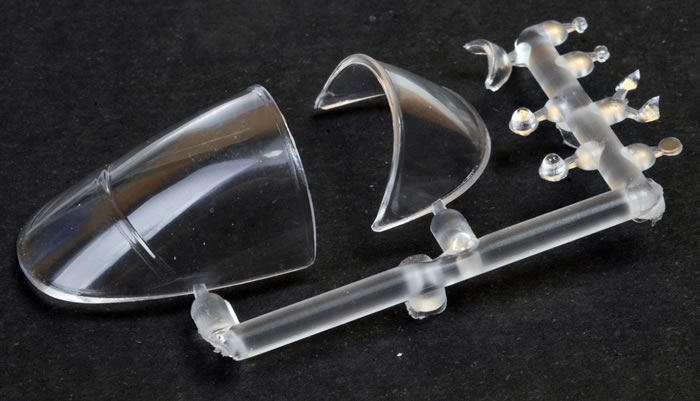
The cockpit detail is an improvement on Airfix’s effort, but frankly, a bit disappointing compared to some other Sword kits in a similar price bracket. The biggest let-down is two resin ejection seats without any harness detail whatsoever, or any firing handles for that matter. The seats are clearly designed to use PE detailing as, for example, is provided with Sword’s Lightning T.4/5 kits. If Sword does not plan to supply PE then they should at least include full harness detail cast integrally with the ejection seats.

There is also a floor; rear bulkhead; two lack-lustre control columns that are nothing like the detailed examples illustrated in the instructions; a throttle quadrant (again different to that illustrated); a bottle that looks like a fire extinguisher; some basic sidewall detail moulded integrally with the fuselage halves; an instrument panel and its coaming. The Strikemaster has two different control panel options and different coaming with cutouts to mount gunsights.
Fortunately, there are after-market resin cockpits from Pavla (Strikemaster) and Obscureco (T.Mk.5) intended for the Airfix kit that should be fine with Sword’s offerings too. The Pavla Set includes a vac-from canopy as well.
The cockpit assembly, short jet-pipe, and nose landing-light bulkhead fit inside the fuselage halves. The nose-lights are covered by a small clear panel. The instructions indicate that nose ballast is required, but not how much. The air intakes drop into place with blanked off sections preventing see-through into the fuselage. Painted matt black, these blanking panels should suffice given the small size of the intakes.
Two small scoops to sit above the centre fuselage are supplied as separate parts, thus ensuring they have a realistic open mouth appearance, as does a single small scoop that locates on the starboard side behind the canopy. A small pitot and its protective bracket fit under the nose centreline, whilst a bulged cover for the elevator actuator mechanism fits below the port tailplane.

The Jet Provost has a strake either side of the lower nose. Where these fit is drawn somewhat differently to the actual raised detail on the kit’s fuselage halves. It also has a nose blade antenna not applicable to the Strikemaster. The Strikemaster has several avionics bulges plus blade and towel-rail antennae on the ventral fuselage and intake undersides, whereas the Jet Provost has only ventral blade antennae and strakes under the intakes. Each kit has a slightly different shaped blade antenna that locates in the same place just to the right of the spine behind the canopy.
With the undercarriage down, the Jet Provost/Strikemaster only has tiny doors open each side of the nose-leg effectively leaving the nose-wheel well closed off. The largest of each pair of main-wheel doors is also closed when the wheels are down. What little of the kit’s main wells is visible includes some detail, but again the kit parts look nothing like the detail illustrated in the instructions. This matters little, as the nicely detailed main undercarriage will block out most of what can be seen. However, I should mention that the actual kit main undercarriage again differs from the instructional drawings; as it butt-fits in place, unlike the insertion fit the instructions indicate. The nose-leg is two parts with a separate wheel-fork, and the anti-shimmy tyre is moulded in two halves in order to provide the raised ridges on the outside of the tyre’s tread.
The wings come with tip-tanks moulded in place, but the Jet Provost has the option of tankless wingtips (required for the aerobatic team markings option). This option requires the tip-tank to be cut off inboard of the aileron’s outboard edge, but leaving the aileron uncut, to create a stepped join; so care will be need for this surgery. Clear wingtip light covers are provided for both the tankless wingtips and more common tanked options. The Jet Provost has one pylon per wing, and the Strikemaster two. Two drop-tanks are the only stores option included with either kit, which in the Strikemaster’s case is a bit of a pity.
The kit is capped off by a two-piece canopy with the option of being modelled open or closed. There is a vertical structural brace to locate on the inside the centre of the windscreen. (Peewit has already released a pre-cut mask for this canopy.)
Overall, I should think that this kit should be an enjoyable one to build, provided you accept that its limited-run nature may demand some fettling here and there. Be aware however, that the instructional drawings do vary in detail from some of the actual kit parts.
Marking Options
Techmod prints the decals, and these are well registered with what appears to be good opacity. I am sure they will prove to be excellent to apply based on my experience of this brand.
The instructions provide two pages of drawings for the Jet Provost and four for the Strikemaster. These give four views and indicate the national insignia, unit markings and stencil locations. I was very pleased to see Sword has provided FS-595 colour references for the RNZAF scheme; the first time I can recall Sword using anything other than generic colour names (I hope this is a new trend for the company!).
The subjects covered are:
-
Jet Provost T.Mk.5:
-
XW287/P, No.6 FTS, 1981, and
-
XW424/52, the Swords Aerobatic Team, NO.3 FTS, RAF Leeming, 1974.
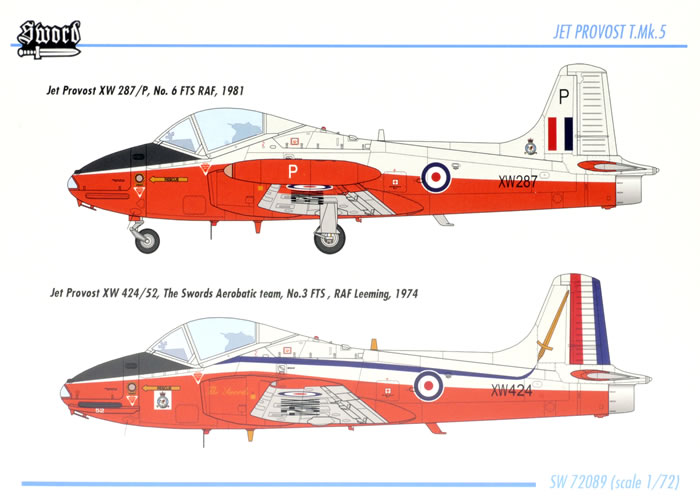

-
Strikemaster:
-
Mk.88, NZ6365, No 14 Sqn, RNZAF (with two camouflage schemes), and
-
Mk.80A, 902/102, Royal Saudi Air Force (with two camouflage schemes).

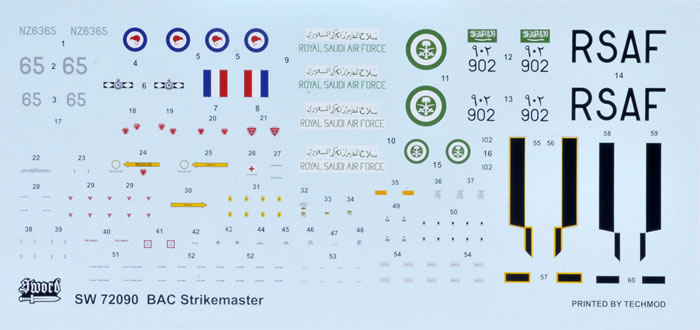
Both kits are a big improvement on the sound but now dated Airfix kit.
I like Sword kits, and this one has many of the brand’s good attributes, not least very nice surface detail. However, after several years of reviewing them, I still feel Sword rushes things to get to market (perhaps because an almost pathological concern amongst many Czech kit makers that someone else will release the same subject first).
There are numerous differences between the constructional drawings and kit parts that hint even more detailed and better kits were intended compared to what has been realised. This ‘sloppiness’ in the instructions fortunately has no real impact on assembly.
The biggest disappointment has to be the ejection seats and their lack of harness detail. Given the huge canopy, this is a poor effort when compared to similar Sword kits. In fact, this subject’s cockpit really warrants the coloured PE treatment like Sword gave their two-seat Lightnings. I am sure buyers would accept a slight price premium for this extra. Fortunately, Pavla’s Strikemaster and Obscureco’s Jet Provost T.Mk.5 resin cockpit sets for Airfix’s kit should suit the Sword kits too.
I happily recommend both kits as being the best examples to date in “The One True Scale”, but lament that their cockpit detail is not on par with Sword’s best.
Thanks to Sword Models for this review sample.
Review Text & Blue Background Images Copyright © 2015 by Mark Davies
Page Created 15 October, 2015
Last updated
15 October, 2015
Back to HyperScale Main Page

|
